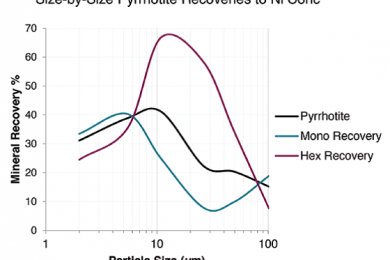Lori Kormos, Principal GeoScientist at XPS asks “do your ores contain pyrrhotite? In many base metal concentrators, the presence of this Fe sulphide can have a negative impact on metallurgy and in some cases can wreak havoc on the economics of an operation. XPS is an industry leader in understanding and minimizing the effect of pyrrhotite on metallurgical performance.
“Ore minerals in base metal sulphide deposits are often mixed with sulphide gangue which must be removed by flotation in order to produce a saleable concentrate. In NiCu orebodies, the sulphide gangue is predominately pyrrhotite, whereas in Cu, CuZn, PbZn deposits, both pyrite and pyrrhotite can be present.
“The degree to which the process is affected by pyrrhotite includes not just the overall pyrrhotite content, but also the ratio of pyrrhotite to economic mineral(s) and the ratio of monoclinic to hexagonal pyrrhotite. XPS has extensive experience and has refined the X-Ray Diffraction (XRD) technique to quantitatively determine the amount of hexagonal versus monoclinic pyrrhotite.
“Historically, pyrrhotite rejection has been successful by using appropriate reagents, pulp density, Eh control all play a role in improving selectivity of the economic mineral versus pyrrhotite. However, the factors listed above tend to be successful on the monoclinic variety and have less of an impact on the hexagonal polytype. Therefore, special attention must be made to ores that contain hexagonal pyrrhotite and measurement of the ratio between the two polytypes is required in order to design a rejection strategy in the flotation circuit.
“XPS has undertaken size-by-size mineralogical analysis of five different base metal concentrators processing both Ni and Zn orebodies along with extensive flotation testing to identify the behaviour of the two varieties of pyrrhotite. Results are remarkably consistent across the different base metal concentrators and indicate that the hexagonal form not only has stronger flotation kinetics than does the monoclinic variety, but that the particle size has an impact on its recovery.
“At XPS, measurement of the ratio between hexagonal and monoclinic pyrrhotite is done by XRD using a calibration curve developed using a variety of polytype mixtures. Mineralogical measurement is the first step in diagnosing pyrrhotite dilution. Developing an appropriate flotation strategy based on the information then becomes a streamlined process.”










